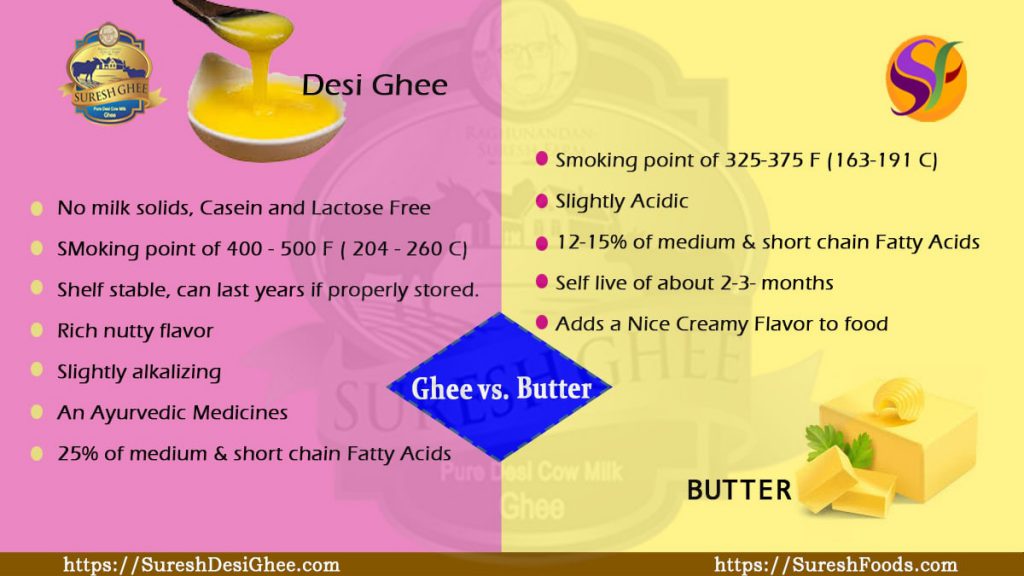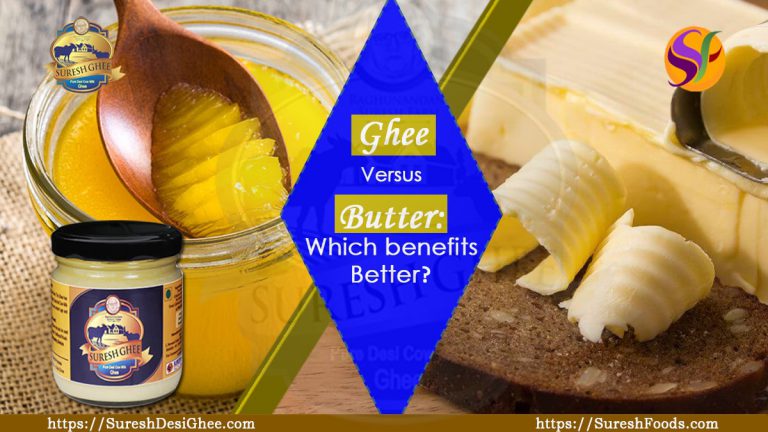Well, we all know that butter and clarified butter ( Ghee ) both are products of milk. However, Clarified Butter has much more benefits than Butter. In desi ghee, you get all the benefits of butter as it is basically butter oil. Ghee is been made by evaporating butterfat, which removes all the moisturizer from the FAT content of butter.
The process of making ghee remove lactose and casein from the product too and makes it consumable for lactose and intolerant people too. Butter is made by curding and churning milk and Ghee is made by simmering butter on high heat and removing impurities from the same, the lastly what we get is butter oil (ghee).
Butter is well-known for its association with high cholesterol because of its hefty saturated fat content. While ghee can be lactose-free and casein-free fat so beneficial for those with dairy sensitivities.
It’s still a fact, too much total fat intake whether monounsaturated, polyunsaturated, or saturated can increase health risks type of cardiovascular disease. There are many health benefits of ghee as per Ayurvedic. Individuals who practised Ayurveda, mainly in India, believe ghee to possess gut cleansing, system boosting, and internal healing benefits.
This belief stems from the actual incontrovertible fact that true ghee following ancient traditions is made with yoghurt-like cultures, which have probiotics. However, most brands of ghee available that are sold in commercial grocery stores aren’t made with cooked cultures, therefore decreasing its health benefits.
Culinary uses of Ghee:
- Ghee is enriched in saturated fatty acids and has high smoke points, which can handle high temperatures without becoming damaged.
- Heating ghee also helps to produce much less of the toxic compound acrylamide as compared to heating vegetable and seed oils.
- Soybean oil produced over 10 times the amount of acrylamide as ghee when each fat was heated to 485°F furthermore, ghee with a high smoke point, due to this the fats become volatile and begin to smoke.
- When cooking at very high temperatures, ghee includes a definite advantage over butter. However, while ghee is more stable at high heat due to its smoke point, butter could even be more suitable for baking and cooking at lower temperatures thanks to its sweeter, creamier taste.

History of Ghee
Desi cow ghee has been used for thousands of years, quite literally. It’s truly an “ancient” health food and definitely not a fad. The first known use of butter was back in 2000 BC. It became very popular in the cooler northern parts of India but didn’t survive well in the southern warmer regions. It’s believed that the southerners are responsible for clarifying butter, in order to keep it from spoiling.
Ghee quickly was integrated into the diet, into ceremonial practice, and into Ayurvedic healing practices. It’s believed to promote both mental purification and physical purification through its ability to cleanse and support wellness.
Ghee benefits the body both inside and out, and is actually used topically to treat burns and rashes as well as to moisturize the skin and scalp. Much like coconut oil, it’s a multi-use fat that is healthy in many ways!
Ghee Benefits vs. Butter Benefits
So how is Ghee better than Butter? Let us see…
Nutrition Profile: Ghee – has a unique nutrition profile without any lactose or casein, but is rich in short-chain and medium-chain fatty acids and butyrate. People who are lactose or casein-sensitive can use ghee because the process has removed these allergens. If you’ve been told to stay away from dairy and butter, experiment with ghee made from grass-fed cow milk!
Butter contains 12-15 per cent medium and short-chain fatty acids, while ghee contains 25 per cent or greater. The body actually metabolizes these fats in a different manner than long-chain fatty acids. The result? Medium and short chains are not associated with cardiovascular disease.
FAT content: Let’s take a quick look at the different kinds of fat and their sources:
- Saturated Fats: Solid at room temperature, examples include butter, lard, suet, and vegetable shortening.
- Unsaturated Fats: Liquid at room temperature, examples include corn oil, safflower oil, soybean oil, avocado oil, sunflower oil, olive oil, canola oil, and nut oil.
- Trans Fatty Acids (Trans Fats): These are artificial fats that are created from liquid vegetable oil to make them solid and shelf-stable.
The differences between Ghee and Butter
Understanding the differences between ghee and butter can help you determine which ingredient to use when cooking.
Ghee has a higher smoke point when compared to butter, so it doesn’t burn as quickly. This is perfect for sautéing or frying foods. Butter can smoke and burn at 350°F (177°C), but ghee can withstand heat up to 485°F (252°C).
Ghee also produces less toxin acrylamide when heated compared to other oils. Acrylamide is a chemical compound that develops when starchy foods are prepared at high temperatures. This chemical has been a known trusted source to increase the cancer risk in lab animals, but it’s unclear whether it also increases the cancer risk in humans.
Because ghee separates milk from fat, this butter substitute is lactose-free, making it better than butter if you have allergies or sensitivities to dairy products. When choosing between ghee and butter, it’s also important to note the different nutritional profiles for each.
Ghee has a slightly higher concentration of fat than butter and more calories. One tablespoon of ghee has about 120 calories trusted source, whereas one tablespoon of butter has about 102 calories trusted source. The differences in fat content vary based on the food manufacturer, but typically ghee has a bit more. Here’s a breakdown:
| Type of fat per tbsp. | Ghee | Butter |
| saturated | 10 g | 7 g |
| monounsaturated | 3.5 g | 3 g |
| polyunsaturated | 0.5 g | 0.4 g |
The fat and calorie differences between ghee and butter are negligible. So, if you’re watching your fat and calorie intake, choosing one over the other may not impact your health.
Understanding what type of FAT is healthy:
Different types of fat should be included in a healthy diet. Monounsaturated fats and polyunsaturated fats help maintain healthy cholesterol levels and offer protection against heart disease. These essential fatty acids come from olives, nuts, seeds, and fish.
Saturated fats should also be included in a healthy diet. These are known as solid fats because they become solid at room temperature. Desi Ghee is the best source of Saturated fat for vegetarians. The body breaks down fat and uses it for energy and other processes.
Unsaturated fats can lower triglycerides and cholesterol, which is why they are healthier than saturated fats. Too much-saturated fat in the blood increases cholesterol and causes plaque to form in blood vessels. As a result, it becomes harder for blood and oxygen to travel through the body. This raises the risk of stroke and heart disease.
Even though unsaturated fats are healthier, they should be consumed in moderation. Too much total fat — whether good or bad — can increase cholesterol and the risk of heart disease and stroke.
Ghee, Butter and Glycemic Index
Glycemic Index : The glycemic index depicts the effect that foods containing carbohydrates leaves on your blood sugar levels as it changes during a day with meals. The result that such foods leave on your blood sugar is compared with the glucose levels, the reference food, which has a glycemic index score of 100 as foods are classified as low, medium, or high glycemic foods.
Butter : Butter is not part of the glycemic index as it does not consist of carbohydrates. Such foods that do not consist of carbohydrates do not directly leave any effect on the blood sugar in the same way that foods with carbohydrates generally do, and they are not involved in the glycemic index. Make sure one should limit their consumption of butter as it contains saturated fat content.
Although, since butter is produced from milk, it involves milk sugar or lactose. Even though, after processing, only a negligible quantity of lactose is left in the butter. Hence, it is not high enough to create a spike in an individual’s blood sugar level. However high in fat, butter will not leave any impact on your blood sugar. Experts recommend less than two tablespoons of butter, but if an individual has a high BMI, cholesterol, hypertension, or diabetes, consume only one teaspoon of butter or in moderate amounts as suggested.
Ghee : Those people who are suffering from diabetes are suggested to consume food with a lower Glycemic Index. Ghee works no differently, adding ghee to meals has shown to lower the overall glycemic index of the food which supports in regulating the blood sugar levels. Such foods that would lead to causing a spike in the sugars would now be controlled. Further major benefit of ghee is that it can be consumed as a topping on steamed rice, such as the addition of ghee supports in the smooth digestion of rice as rice is otherwise a problem-causing food for a person living with diabetes which can now becomes edible to some extent with medicinal properties of ghee.

Naveen m...